October 1935 - The Robinson Ice Cream Co.
Ltd opened their Grey Lynn factory extension,which doubled
the area and resulted in the largest and most modernly-equipped ice
cream factory in New Zealand. Their 1936 product range listed Robinson's
Pure Ice Cream, Eskimo Pies, Snow Ice, Rainbow Blocks, and Real Fruit
Ice Cream.
The '30s saw the country's first Labour government, a new wave of socialism,
and increased recognition of worker's rights.
In 1936 the Ice Cream & Related Trades Union was
registered, and by November of that year, negotiations over pay and conditions
had already broken down and were before the Conciliation Commissioner.
An Award was finally agreed by March 1938 (for employees of ice
cream manufacturers within a 25 mile radius of Wellington), the
main features
of which were a working week of five and a half eight-hour days in summer,
and four and a half eight-hour days in winter. Minimum weekly rates of
pay were: - lce Cream Maker, £6; Assistant Ice Cream Maker, £5
5s; ice cream storemen, £5; general hands, £4 10s; youths
under 17 years of age, £1.
1937 - The New Zealand Herald published an article
on 6 November titled "In an Ice Cream Factory - The
History of These Tasty Delights", "Specially
Written for Boys and Girls by OLGA P. MEYER":
Ice-cream really begins as
milk; really good creamy milk, to which is added a certain amount
of sugar and gelatine.
Each morning fresh milk is mixed with these other things, and put
into a big tank where it is pasteurised (which means heating gradually
up to 145 degree Fahrenheit to destroy germs). The tank has what
is known as a water-jacket; that is to say, it really has double
sides, between which water circulates. When the water is heated,
and the required temperature for pasteurisation reached, cold water
is turned on until the mixture in the tank is about 110 degrees Fahrenheit.
This mixture is called "raw mix," which then passes into a "viscoliser," which
is a machine working under pressure of three thousand pounds to
the square inch, and which splits up the little fat
globules, giving
the mixture its smooth texture.
In pipes the "raw mix" then passes into a cooler, where
an intricate system of piping is surrounded by water,
and from here, still in
pipes, the mixture is passed into an aging vat. Here the water-jacket
has an ammonia coil in it too, and as this cools it more than water
alone would, the temperature quickly falls from about 60 degrees
to 42 degrees.
From twenty-four to seventy-two hours the "raw mix" remains
in this vat, and from here it passes into a churn where
it is whipped up,
and flavouring added if desired.
It is an interesting fact that from the time the milk is poured into
the first tank, until the mixture reaches the churn, it travels all
the time in enclosed pipes.
From the churn it is put into cans of various sizes, holding from
one gallon to five gallons, and then it is placed in very cold rooms
to harden. The temperature of these rooms is from zero to ten degrees
below, so you can imagine how chilly that would be!
After about ten hours of this, the icecream is ready to go out into
the van for delivery to the shops. These vans are specially made,
and have very thick cork-lined walls, to keep out any heat that might
penetrate and soften the ice-cream.
I think everyone knows what happens to ices after they reach the
shops! |
Ice Cream, The Health Food

Peters Ice Cream advertisement, Auckland Star, 19 December 1936.
Ice cream's health-giving properties were a major selling point, especially
as the country emerged from the Great Depression. Ice cream, as a dairy
product, was considered to have a high food value, and claims were
made that it was “extremely valuable … in some of the
most serious forms of illness and in convalescence.”
1937 - In a world first, the first Labour
government, in an effort to improve the health of young New
Zealanders (and use up surplus milk), had introduced a scheme
to supply free milk to schoolchildren.
In what could have been an even more popular public health breakthrough,
it was proposed in December 1938 that instead of milk,
ice cream be given free to children in schools. Unfortunately for our
grandparents, this far-sighted idea wasn't taken up by the government,
but at the time the Evening Post reported:
Mr. W.
R. Nicol. chairman of the Wairarapa Milk Committee, favours
the proposal and considers
that the supply of ice-cream would be well worth trying as
an experiment. He pointed out that it would cost about £3000
to provide the necessary equipment to enable milk to be supplied
to the school children under the desired conditions, whereas
it should be possible to handle ice-cream much more cheaply
than that.
He intended to discuss the matter with Mr. J. Robertson, M.P. If
the proposal is adopted there is no question as to its popularity
with the children.
In making the suggestion in the first place, Mr. Russell said ice-cream
had a richer food value than milk, it was readily digested, children
liked it, it was easy to store and distribute, and there was no waste. |
The Modern Milk Bar
10 October 1935 - The original Tip Top Milk Bar,
was opened at 36 Manners St., Wellington, by Len Malaghan and Bert
Hayman's company Health Foods Ltd., selling
only ice cream and milkshakes.
The Evening Post reported that it was "Wellington's first milk bar",
following the popularity of this type of business overseas.
" Milk and ice cream are basis of almost all the many
varieties of drink obtainable at the bar, which is equipped with
modern electrical devices for the freezing and mixing of the
drinks. It is anticipated that the milk required for it will
be between 200 and 300 gallons a week."
|